Understanding Age-Specific Presentation of Psychiatric Conditions
As the global population ages, understanding how psychiatric diagnoses manifest differently in older adults becomes increasingly vital. Unlike younger populations, seniors often display atypical or subtle symptoms that can mask or mimic physical illnesses, complicating accurate diagnosis. This article explores the unique presentations, clinical signs, diagnostic considerations, aging impacts, and evidence-based strategies essential for effective mental health care in senior populations.
Atypical and Age-Related Symptoms in Psychiatric Diagnoses
What are the age-specific presentations of psychiatric diagnoses in older adults?
Psychiatric conditions in older adults often manifest differently than in younger populations. This variation is due to age-related biological, psychological, and social changes that influence the presentation of mental health disorders.
In depression, traditional symptoms like persistent sadness or crying are less common. Instead, older adults may exhibit fatigue, loss of interest, cognitive complaints, irritability, or physical complaints such as aches and pains. These somatic and behavioral signs can mask underlying depression, making diagnosis challenging.
Similarly, anxiety disorders often present with worries about health, sleep disturbances, or physical symptoms, such as rapid heartbeat or dizziness. Older adults might describe these symptoms using different language, emphasizing bodily sensations rather than emotional distress.
Cognitive disorders, including various types of dementia, typically involve a slow decline in memory, problem-solving, and executive functioning. Early neuropsychiatric symptoms such as agitation, paranoia, or hallucinations can precede noticeable cognitive decline.
Social issues like grief, social isolation, and functional impairments further complicate diagnosis. For example, prolonged grief can resemble depression or become co-morbid with it, especially when compounded by loss of loved ones or reduced social support.
Recognizing these age-specific symptom patterns requires comprehensive assessments that include cognitive testing (like the MMSE or Neuropsychological testing), functional evaluations (using tools like the Lawton IADL), and psychosocial assessments. Incorporating collateral information from family members or caregivers enhances diagnostic accuracy.
In summary, understanding the unique presentation of psychiatric illnesses in older adults facilitates accurate diagnosis and tailored treatment. Awareness of these age-related differences ensures that clinicians consider both medical and social factors contributing to mental health in late life.
Variations in Symptoms and Clinical Signs of Mental Health Conditions
How do symptoms and clinical signs of mental health conditions vary in seniors?
The presentation of mental health issues in older adults often differs significantly from that in younger populations. Unlike the traditional symptoms of depression, anxiety, and psychosis seen in younger individuals, seniors may display more subtle or unusual signs.
A common manifestation includes confusion, disorientation, or sudden falls, which can be mistaken for neurological or physical health issues. These signs may be early indicators of underlying psychiatric conditions, but often go unrecognized due to their nonspecific nature.
Atypical symptoms such as somatic complaints—like chronic pain, fatigue, or gastrointestinal disturbances—and sleep disturbances are frequently observed. Older adults might report physical symptoms that overshadow or mask emotional or psychiatric problems.
Another challenge is that cognitive decline, whether from dementia or other neurological conditions, can complicate the diagnosis. For example, depression can present as cognitive impairment or slowed thinking rather than overt sadness.
Medication side effects and physical health issues also influence symptom presentation. Many seniors are on multiple medications, which may cause side effects such as sleep disruption or confusion, further complicating clinical evaluation.
Social factors like loneliness, social isolation, and grief can worsen mental health symptoms or delay help-seeking. This makes early detection and tailored assessments critical.
Overall, recognizing the varied and often subtle signs of mental health conditions in older adults requires clinicians to have a high index of suspicion. Personalized, comprehensive assessments—including psychological, medical, and social evaluations—are essential to accurately diagnose and effectively treat mental health issues in this population.
Diagnostic Challenges Unique to the Senior Population
What diagnostic considerations are unique when assessing mental health in the senior population?
Assessing mental health in older adults presents unique challenges that differ from younger populations. One of the primary considerations is the frequent co-occurrence of physical illnesses, such as cardiovascular disease, diabetes, or neurological conditions, which can mimic or mask psychiatric symptoms. For example, depression may present as fatigue or cognitive impairment, while medical illnesses can cause hallucinations or mood changes.
Another critical factor is differentiating between typical age-related changes and pathological conditions. Mild forgetfulness or slowed processing speeds can be normal with aging, but significant memory loss or disorientation signal possible dementia or other neurocognitive disorders. Tailored screening tools like the MMSE (Mini-Mental State Examination) or Mini-Cog are designed to better identify these conditions in the elderly.
Polypharmacy is common among seniors, often involving multiple medications for various chronic illnesses. Some drugs have neuropsychiatric side effects or interactions that can produce symptoms resembling mental health disorders. Reviewing and optimizing medication regimens are essential steps in the diagnostic process.
Social factors, including loneliness, social isolation, and experiences of ageism, substantially influence mental health and may complicate diagnosis. These psychosocial elements should be incorporated into comprehensive assessments to provide context to the symptoms.
Furthermore, standard diagnostic criteria might underestimate psychiatric disorder prevalence because they are primarily based on younger populations and may not capture age-specific presentations like somatic complaints or atypical depression.
Given these factors, a multidisciplinary approach that includes medical evaluation, psychological testing, and social assessment is indispensable. This holistic method ensures accurate diagnosis, preventing misclassification and guiding personalized treatment strategies tailored to the complexities of aging.
Table: Comparative Overview of Geriatric Psychiatric Assessment Considerations
| Aspect | Typical Presentation in Younger Adults | Age-Related Changes | Special Considerations |
|---|---|---|---|
| Cognitive Function | Standard testing | Decline in processing speed | Use age-adjusted screening tools |
| Physical Illnesses | Less common | More prevalent | Impact symptom expression |
| Medication Effects | Less influence | Increased due to polypharmacy | Watch for side effects and interactions |
| Social Factors | Varying impact | Increased influence | Assess for loneliness and social support |
This comprehensive understanding guides clinicians in delivering nuanced, effective care tailored to older adults' unique diagnostic needs.
The Impact of Aging on Mental Health Diagnosis
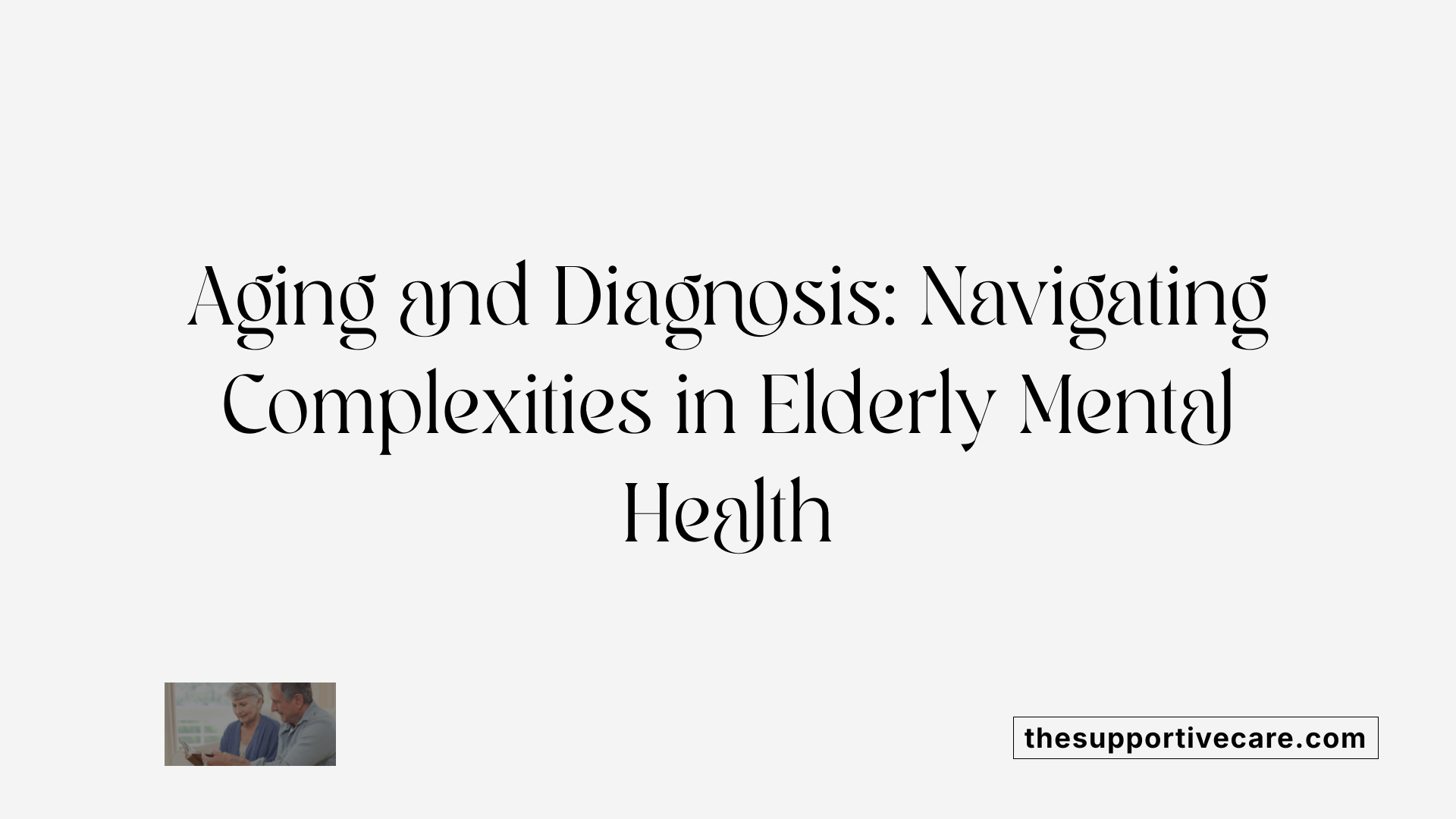
How does aging impact the diagnosis of mental health conditions?
Aging significantly influences how mental health conditions are diagnosed, often complicating the process for clinicians. One primary challenge is that symptoms of psychiatric disorders in older adults frequently overlap with those of physical illnesses or age-related changes. For example, depression may manifest as fatigue, sleep disturbances, or cognitive impairment—symptoms that are also common in medical conditions like thyroid problems, neurological disorders, or cardiovascular disease.
Moreover, older individuals may present with atypical symptoms that do not align with standard diagnostic criteria mainly developed from younger populations. This can result in underdiagnosis or misdiagnosis, particularly when communication difficulties or cognitive decline hinder accurate reporting of symptoms.
Social factors also play a role. Stigma associated with mental health, especially prevalent among older generations, discourages many from seeking help. Social isolation and bereavement—common in later life—can mimic or mask mental health issues, making detection even more challenging.
Healthcare disparities further exacerbate these issues. Limited access to mental health specialists, underinsurance, and short or infrequent medical visits reduce opportunities for thorough assessment.
Consequently, many older adults suffer from untreated conditions, which can lead to deteriorating overall health, increased risk of disability, accelerated cognitive decline, and higher mortality rates. Recognizing the subtle and complex presentation of mental health issues in this population requires careful, age-sensitive evaluation and a holistic approach to healthcare.
Evidence-Based Assessment Strategies for Older Adults' Mental Health
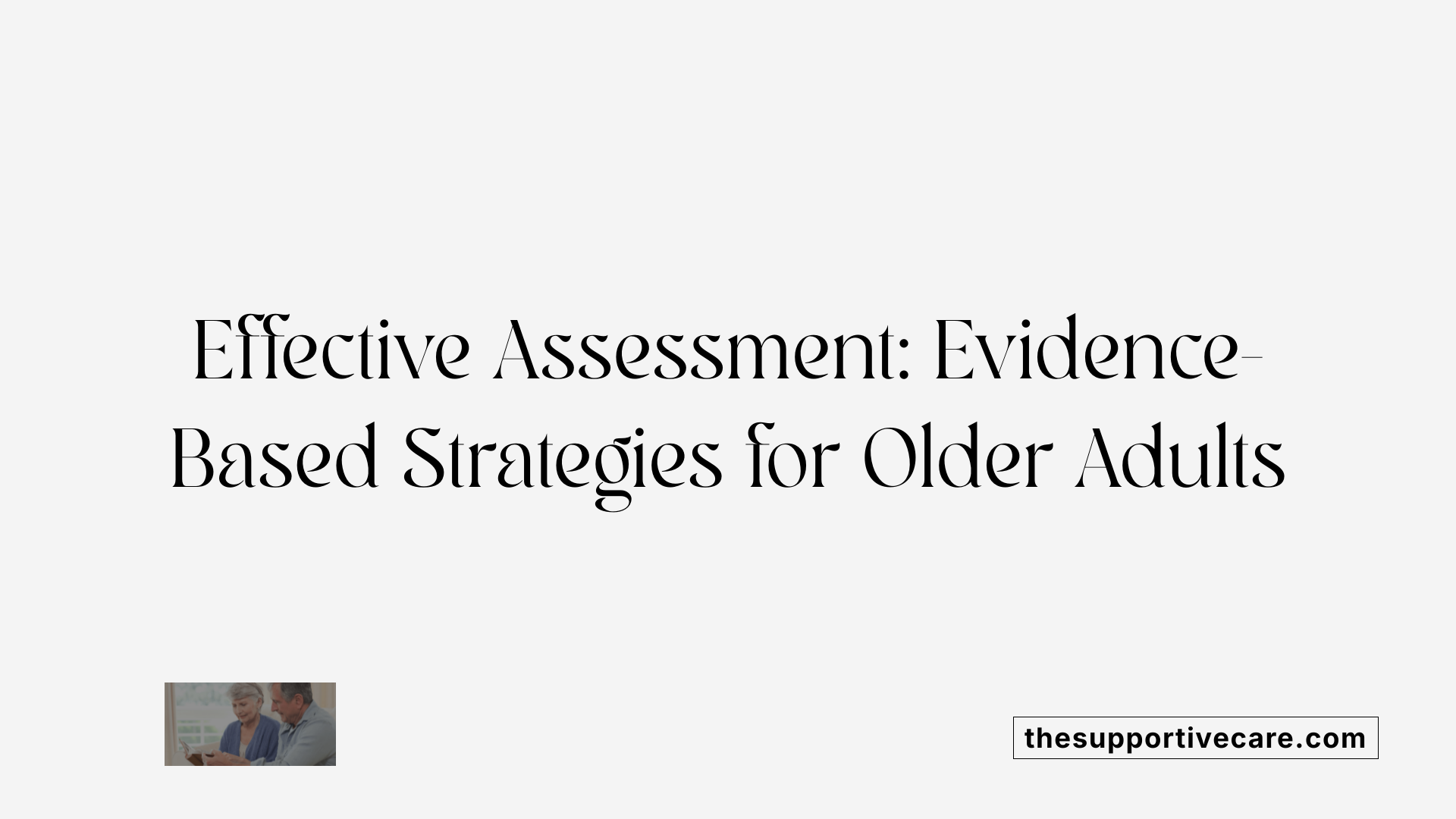
What are the best evidence-based practices for diagnosing mental health issues in older adults?
Diagnosing mental health conditions in older adults requires a comprehensive, multi-faceted approach that accounts for age-specific presentations and overlapping medical issues. Evidence-based practices combine clinical history-taking, collateral reports, and structured neuropsychological testing. Validated screening tools such as the Mini-Mental State Examination (MMSE), Montreal Cognitive Assessment (MoCA), and other cognition-based inventories are critical in assessing cognitive function and identifying early signs of neurocognitive disorders.
Neuroimaging techniques like magnetic resonance imaging (MRI) and computed tomography (CT) scans help detect structural brain changes related to conditions such as Alzheimer's disease and other dementias. Emerging biomarkers—including blood-based measures like phosphorylated tau (pTau) and neurofilament light chain (NfL)—show promise in early detection and differential diagnosis of neurodegenerative disorders.
Applying standardized diagnostic criteria, such as those outlined in the DSM-5, ensures consistency and accuracy in diagnosis. For neurobiological assessments, the AT(N) framework classifies biomarkers of amyloid deposition (A), tau pathology (T), and neurodegeneration (N), helping distinguish between different types of dementia.
A holistic approach also involves collateral information from family members and caregivers, neuropsychiatric assessments, and evaluation of functional capacities using scales like the Lawton IADL or the OARS questionnaire. These evaluations inform treatment plans that are tailored to the complex interplay of medical, psychological, and social factors unique to older adults.
Finally, multidisciplinary teams, including psychiatrists, neurologists, psychologists, social workers, and primary care providers, collaborate to synthesize clinical, neuropsychological, and biomarker data. This integrated approach enhances diagnostic accuracy, informs personalized interventions, and improves overall outcomes for older adults facing mental health challenges.
The Role of Neurocognitive Disorders and Neuropsychiatric Symptoms in Older Adults
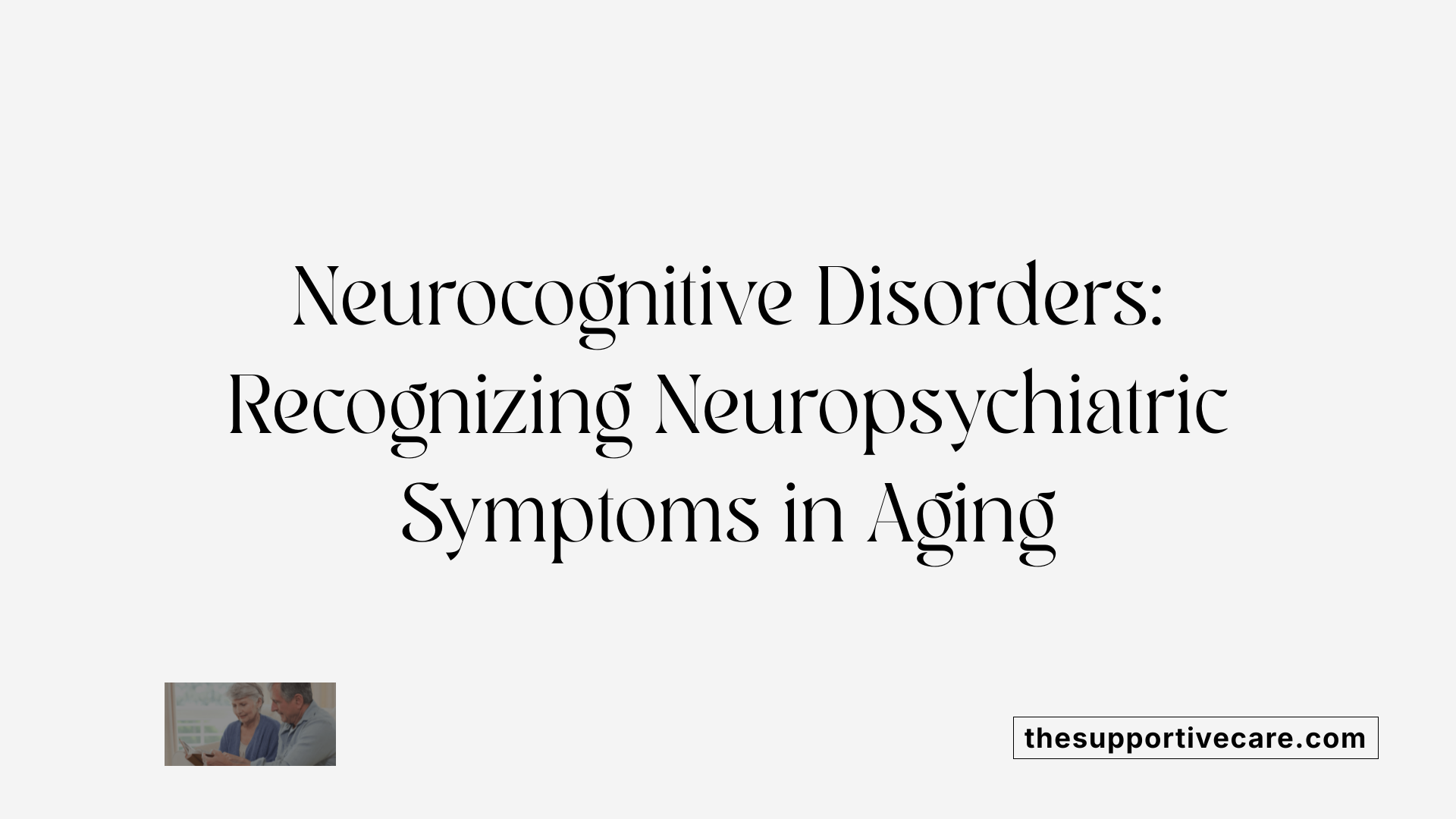
How do neurocognitive disorders present with neuropsychiatric symptoms in older adults?
Neurocognitive disorders, such as Alzheimer’s disease and other forms of dementia, frequently manifest through neuropsychiatric symptoms. These symptoms include agitation, depression, hallucinations, psychosis, and sleep disturbances. Importantly, such behavioral changes can appear early, even before significant cognitive decline becomes apparent. For example, older adults may show irritability, anxiety, suspiciousness, or behavioral disturbances that can be misinterpreted as primary psychiatric illnesses.
The neurobiological changes underlying these disorders, like cortical atrophy and disruptions in neurotransmitter systems, contribute to these neuropsychiatric presentations. These symptoms can sometimes be mistaken for medical issues such as delirium or depression, making accurate diagnosis challenging but crucial.
Understanding these early signs is vital, as early detection of neurocognitive disorders can lead to more effective management and potentially slow disease progression. A thorough assessment — including neuropsychological tests, medical evaluations, and collateral history from caregivers — is often necessary to distinguish neurocognitive disorders from primary psychiatric disorders. Proper identification ensures appropriate interventions, improving quality of life and care outcomes for older adults.
The Influence of Social and Environmental Factors on Senior Mental Health
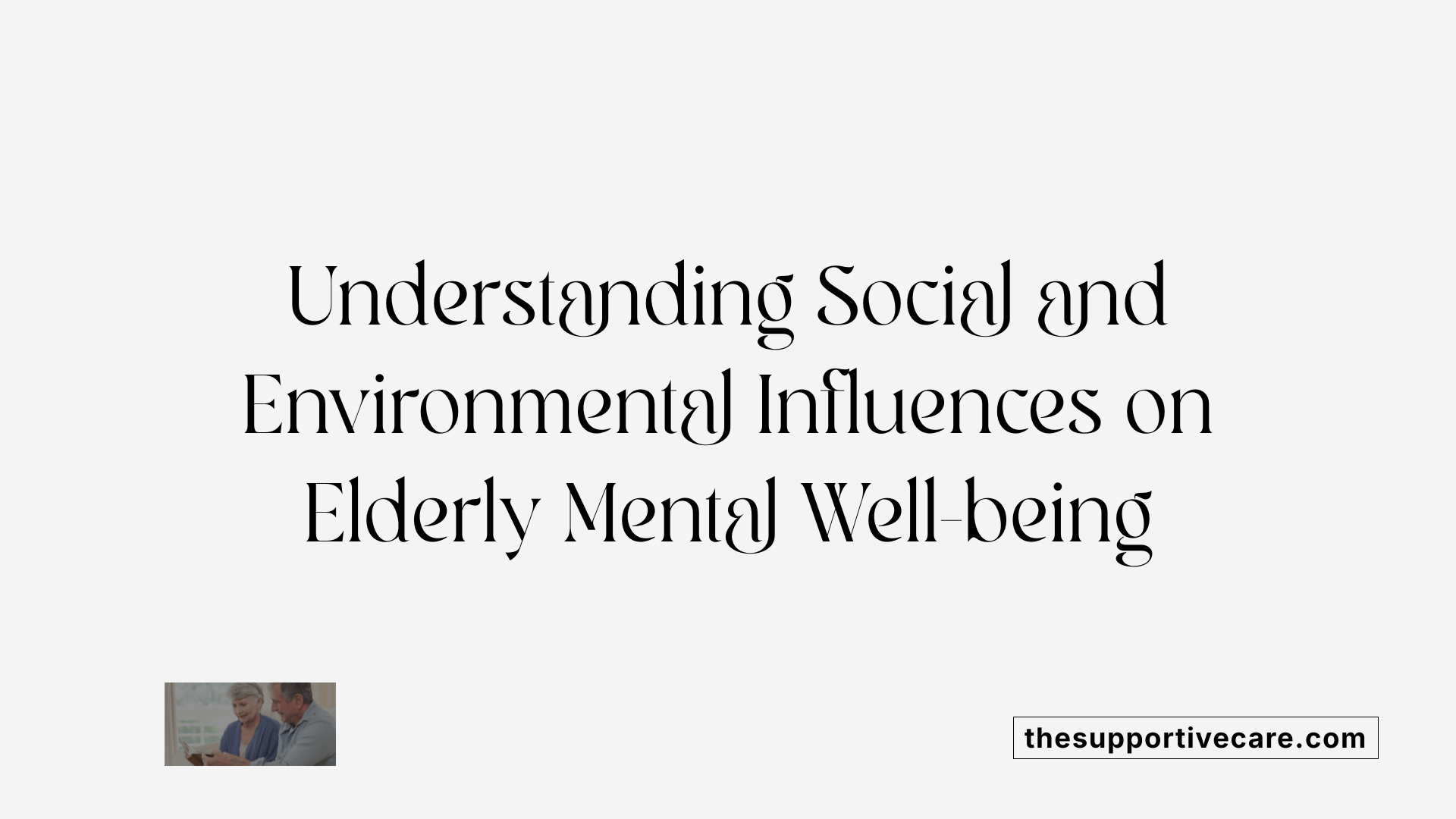
How do social factors influence mental health presentation and diagnosis in older adults?
Social factors such as loneliness, social support, and community engagement play a crucial role in shaping mental health in older adults. Loneliness and social isolation are widespread issues, affecting roughly a quarter of seniors. These conditions significantly increase the risk of developing mental health problems like depression and anxiety.
Conversely, active social support and involvement in community activities can help older individuals build resilience and maintain emotional well-being. Strong social networks often lead to earlier recognition of mental health symptoms and better treatment adherence.
Bereavement and loss are inevitable aspects of aging, potentially leading to grief that mimics or overlaps with depression. When grief persists or becomes complicated, it can trigger or deepen depressive episodes. Recognizing the difference between normal grief and clinical depression is vital for appropriate intervention.
Living arrangements—whether living alone, with family, or in assisted living—also influence mental health. Those living alone may experience greater loneliness and have fewer opportunities for support, complicating diagnosis and management. Community engagement, including participation in social groups or activities, contributes positively to mental health.
Cultural attitudes and societal stigma toward mental illness, especially among older generations who may have come of age when mental health was less openly discussed, often hinder help-seeking behaviors. Such stigma can lead to delayed diagnosis, inadequate treatment, or outright avoidance of mental health resources.
Addressing these social and environmental factors requires targeted efforts such as community-based programs that foster social connections, anti-stigma campaigns, and initiatives to improve access to mental health services for seniors. Reducing social isolation and promoting supportive environments are essential steps toward better mental health outcomes in the aging population.
Understanding the Decrease of Emotional Lability and Increase in Positive Affect in Older Age

How does aging impact emotional well-being and affect regulation?
Research shows that as people age, their emotional landscape changes significantly. Older adults often experience less sadness, depression, and negative emotional states compared to younger individuals. This reduction in negative affect is complemented by an increase in positive feelings, contributing to a general sense of emotional stability.
Aging brings about both psychological and physiological changes that influence how emotions are regulated. Psychologically, seniors develop better coping skills and emotional regulation strategies through life experience. They tend to interpret stressful events more adaptively and maintain a balanced outlook, which helps in reducing emotional volatility.
Physiologically, aging can lead to reduced bodily flexibility and resilience, making some older adults more susceptible to certain symptoms like sleep disturbances, fatigue, and cognitive issues. These physical vulnerabilities can sometimes complicate the recognition and diagnosis of emotional distress.
Despite these vulnerabilities, the overall trend points to greater emotional well-being in late life. Seniors generally display less emotional lability, meaning their mood swings and emotional outbursts are less frequent. This emotional stability is thought to stem from accumulated life perspective, priorities, and a focus on positive experiences.
Understanding how aging influences emotions is vital for clinicians. A decrease in negative affect should not automatically be viewed as a sign of absence of distress. Instead, it reflects an age-related enhancement in emotional regulation, which can sometimes mask underlying issues.
In summary, the combination of accumulated wisdom, better emotion regulation strategies, and a more positive life perspective contributes to the emotional resilience observed in older adults. Recognizing these changes enables better mental health support and tailored interventions for this population.
Gaps in Workforce Training and Service Access for Gerontological Mental Health Care
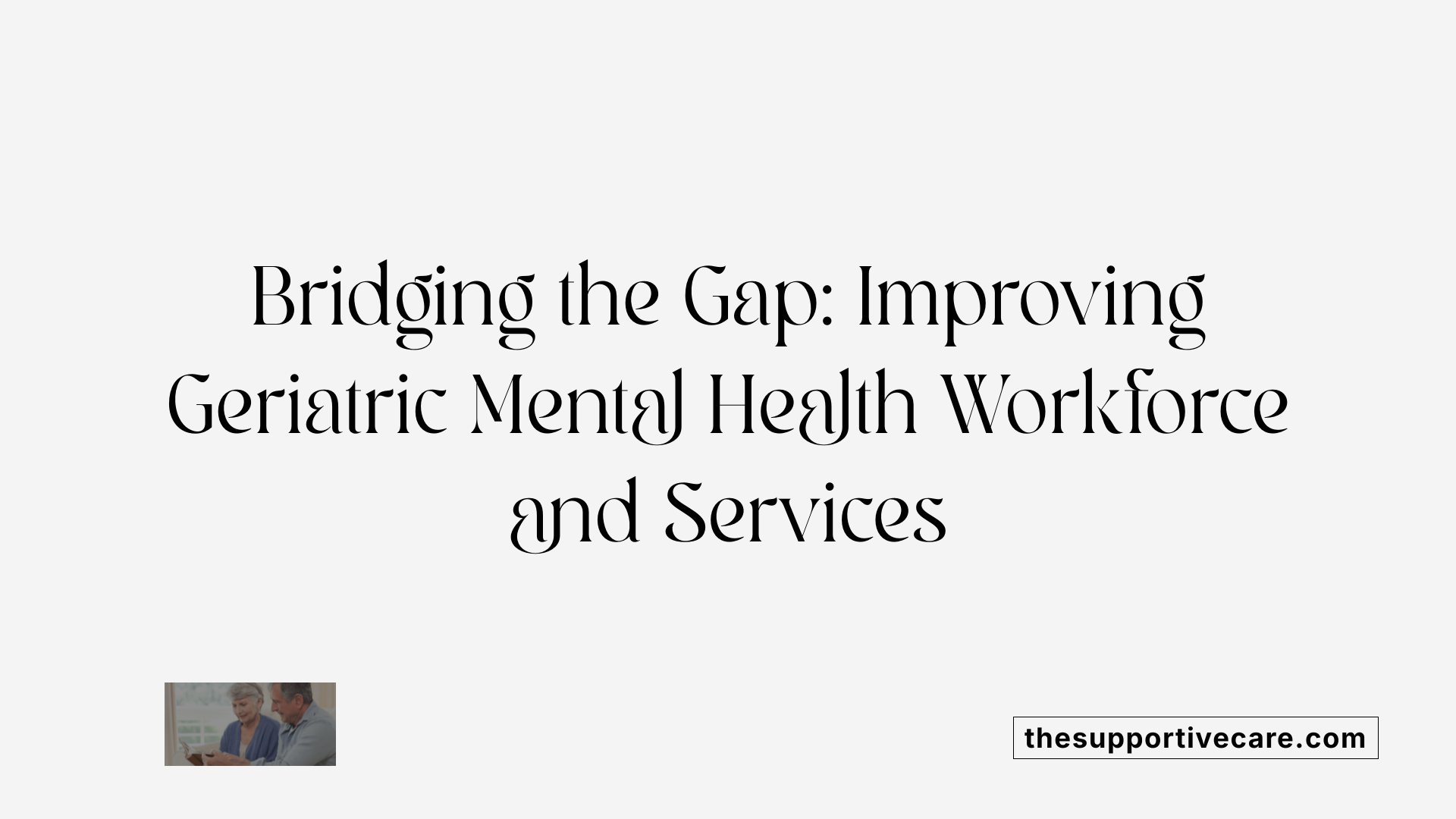
What are the challenges in diagnosing and treating mental health conditions in the elderly and how can they be addressed?
Accessing effective mental health care for older adults involves multiple obstacles. One significant barrier is the shortage of trained geriatric mental health providers, including psychiatrists, psychologists, social workers, and nurses who have specialized skills in aging-related mental health issues.
Many healthcare professionals lack sufficient training in geriatric psychiatry, which affects accurate diagnosis and appropriate treatment. Age-related changes can mask or mimic psychiatric symptoms, making assessment challenging. For example, depression might present as physical discomfort or cognitive decline, leading to underdiagnosis or misdiagnosis.
Additional barriers include limited insurance coverage and very short doctor appointments, which leave little time for comprehensive mental health assessments. Societal stigma around mental illness in older age also discourages many from seeking help.
Addressing these issues requires a multifaceted approach. Expanding workforce training programs in geriatrics and mental health can improve provider competence. Integrating mental health services into primary care settings can help reach more older adults and facilitate early detection.
Advocacy efforts are crucial to promote policies that incentivize collaborative, multidisciplinary care approaches tailored for seniors. Community-based programs, telemedicine initiatives, and public awareness campaigns to reduce stigma are also effective strategies to improve service accessibility and quality.
Overall, overcoming these barriers can lead to better diagnosis, more personalized treatment, and improved mental health outcomes for the aging population.
Impact of Medication and Treatment Responses in Late-Life Psychiatric Disorders
How does aging affect treatment responses and medication management in seniors with psychiatric conditions?
Treatment responses in older adults with psychiatric disorders are highly variable, influenced by factors such as the complexity of underlying causes, coexisting medical conditions, and individual differences. As people age, their bodies undergo physiological changes that can affect how medications are absorbed, distributed, metabolized, and eliminated. These changes increase the risk of adverse effects and drug interactions, making medication management more challenging.
In particular, antipsychotics used for conditions like schizophrenia or agitation need cautious use. They carry risks of sedation, metabolic disturbances, cardiovascular issues, and even increased mortality—especially in older adults with dementia-related psychosis. Therefore, clinicians emphasize personalized treatment plans that minimize side effects, involve shared decision-making, and include close monitoring.
Adjusting dosages based on age, renal and hepatic function, and concomitant medications is essential. Non-pharmacologic strategies, such as behavioral therapies and social support, are often incorporated to optimize outcomes. Recognizing that many seniors have multiple health issues and are on polypharmacy regimens helps prevent adverse interactions and supports safer, more effective treatments.
Ultimately, managing psychiatric conditions in older adults demands a careful balance—addressing mental health needs while safeguarding physical health. Personalized care approaches that adapt to each patient's unique physiological and social context are critical for improving quality of life in this population.
Emotional Well-Being and Psychological Resilience in Older Adults
How do older adults experience serenity and life satisfaction?
Many older adults report feeling a greater sense of serenity and contentment as they age. This positive emotional outlook is often due to improved emotion regulation skills developed over a lifetime. They tend to focus more on meaningful relationships and personal growth, rather than attachment to material possessions or external validation.
Is there a tendency toward lower negative affect among seniors?
Research consistently shows that seniors experience less frequent negative emotions like sadness, anger, and anxiety compared to younger individuals. They also tend to exhibit more positive affect, which contributes to overall emotional stability. This decrease in negative affect is linked with age-related improvements in coping strategies and emotional control.
How do older adults adapt and grow emotionally?
Aging is associated with both psychological enhancements and physiological vulnerabilities. While there may be reduced physiological resilience, many older adults demonstrate remarkable adaptation, showing increased wisdom and emotional intelligence. They often better handle stress, loss, and life transitions, leading to a sense of resilience and well-being.
| Aspect | Description | Additional Notes |
|---|---|---|
| Serenity & Satisfaction | Higher life satisfaction; focus on meaningful relationships | Gains in gratitude and acceptance |
| Negative Affect | Less frequent; emotional regulation improves | Less emotional lability |
| Emotional Growth | Increased wisdom; better coping; adaptation to aging | Resilience despite biological vulnerabilities |
This emotional growth and resilience contribute significantly to mental health, helping many seniors navigate life's challenges with a sense of peace and fulfillment, despite health or social limitations.
Future Perspectives and Policy Implications in Geriatric Psychiatry
As the global population ages, with projections estimating that by 2030 one in six people will be over 60, the importance of tailored mental health strategies for older adults becomes increasingly clear.
Research efforts need to expand to better understand the unique neurobiological and psychosocial factors affecting this demographic. This includes investigating age-specific presentations of conditions like depression, anxiety, and psychosis, as well as refining diagnostic tools to improve accuracy.
Training initiatives are critical to address the significant gaps in workforce expertise. Developing specialized programs for geriatric mental health care aims to equip clinicians with the skills needed to manage complex cases involving comorbid medical and psychiatric conditions.
Models of integrated care, which combine mental and physical health services, hold promise for improving outcomes. These collaborative approaches facilitate early detection and comprehensive treatment, especially as older adults often prefer receiving mental health services within primary care settings.
Public health policies must also evolve to support these efforts. This includes expanding insurance coverage for mental health treatments, promoting anti-stigma campaigns, and implementing community-based interventions aimed at reducing loneliness and social isolation — key risk factors for mental health disorders.
Collectively, these strategies aim to transform geriatric psychiatry from reactive treatment to proactive prevention and holistic care, ensuring older adults maintain mental well-being and quality of life as they age.
Enhancing Mental Health Diagnosis and Treatment in Seniors
Accurate diagnosis and effective management of mental health disorders in older adults require an understanding of age-specific presentations, symptom variability, and diagnostic challenges. Implementing comprehensive, multidisciplinary assessment strategies and addressing systemic barriers can improve detection and care. As the global population ages, investment in workforce training, integrated care models, and research is essential. Recognizing the complex interplay of biological, social, and psychological factors will ensure that mental health services are tailored to the unique needs of senior populations, ultimately improving their quality of life and well-being.
References
- Mental health care for older adults: recent advances and ...
- Mental health of older adults
- Psychiatric Assessment and Diagnosis in Older Adults
- Older Adults Are Being Overlooked When it Comes to ...
- Age differences in mental health disorder recognition
- Older Adults Living with Serious Mental Illness
- Sadness and Worry in Older Adults
- Mental Health and the Older Adult




































































































